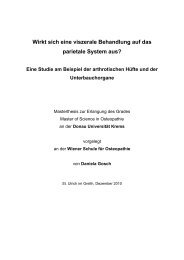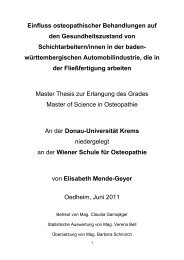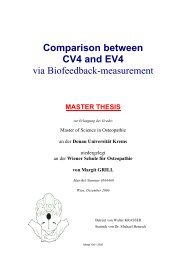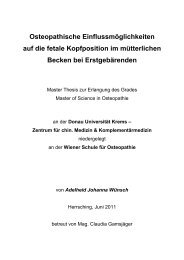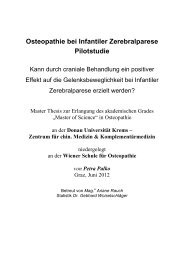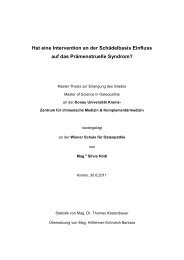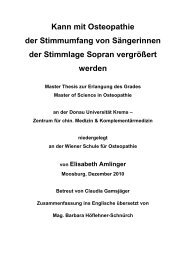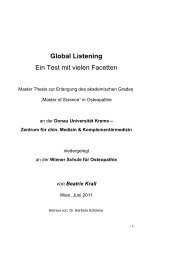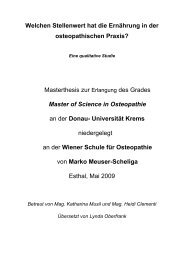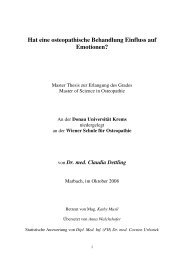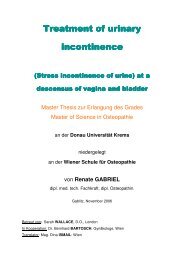Risch Andreas.pdf - Osteopathic Research
Risch Andreas.pdf - Osteopathic Research
Risch Andreas.pdf - Osteopathic Research
Sie wollen auch ein ePaper? Erhöhen Sie die Reichweite Ihrer Titel.
YUMPU macht aus Druck-PDFs automatisch weboptimierte ePaper, die Google liebt.
1 Introduction<br />
The questions „What is health? What is illness?“, are challenging the philosophical,<br />
scientific and professional concepts of osteopaths.<br />
<strong>Osteopathic</strong> thought, speech and practice is influenced by the philosophical<br />
principals which are laid down by A.T. Still, J.M. Littlejohn and W.S. Sutherland and<br />
their students. In osteopathic literature abstract and complex terms like health are<br />
expressed mainly by metaphors. <strong>Osteopathic</strong> language seems to be one of the major<br />
problems (Liem et al., 2008), especially the conceptualization of basic terminology<br />
like health and illness through metaphors in thinking, speaking and acting.<br />
In osteopathic literature, there are many metaphors for health, e.g.: HEALTH AS<br />
PERFECTION AND HARMONY (Still), HEALTH AS FLUID LIGHT (Sutherland),<br />
BREATH OF LIFE (Sutherland), LIVING PRINCIPLE IN A LIVING BODY (Becker),<br />
HEALTH AS WHOLENESS (Jealous), HEALTH AS FLOWING WATER (Baumeler)<br />
etc.<br />
The metaphor is defined by the two cognitive linguists, Lakoff and Johnson, in the<br />
following way: „The essence of metaphor is understanding and experiencing one kind<br />
of things in term of another“ (Lakoff/Johnson, 1980). A conceptual metaphor is<br />
consequently the experience and understanding of one aspect of reality through<br />
another (Schmitt, 1995). As a rule, we normally use a familiar, concrete and culturally<br />
embedded treasure of experience in order to grasp an abstract content which is<br />
difficult to comprehend. (Schiefer, 2005).<br />
In her study with thematically structured interviews, Schachtner shows how medical<br />
practice is constituted on the basis of metaphors. This includes how doctors reach<br />
their diagnosis, what medical decisions they make and how they form the physicianpatient<br />
relationship (Schachtner, 1999).<br />
As Lakoff/Johnson have pointed out the aspect of „Hiding and Highlighting“ of<br />
metaphors (Lakoff/Johnson, 1980), other authors (Rijn van Tongeren, 1997 u.<br />
Schiefer, 2005) also critically refer to the important circumstance, that metaphors



